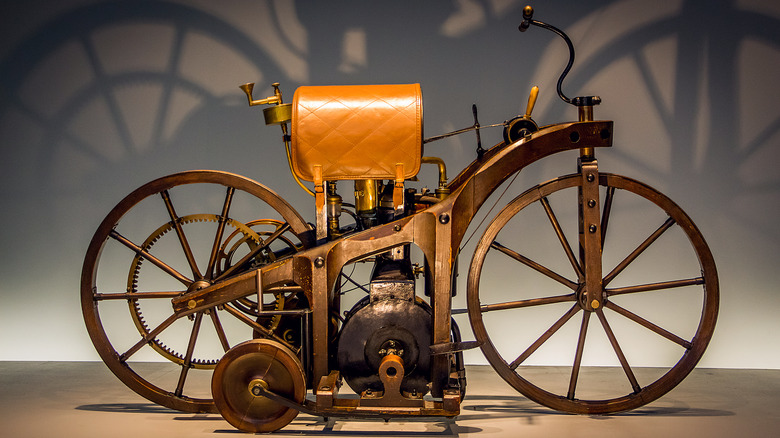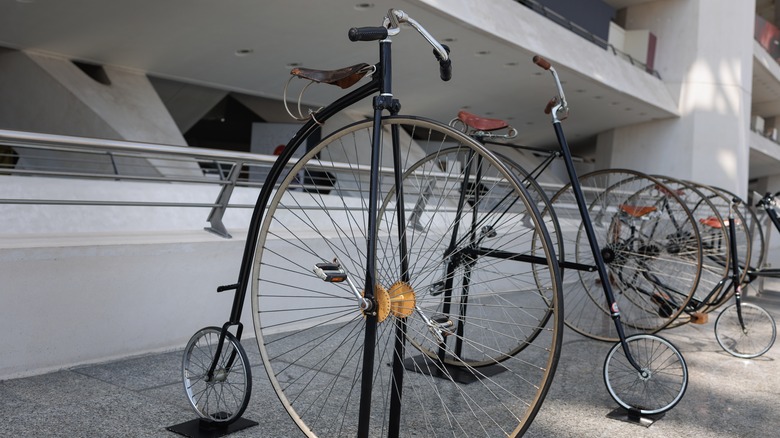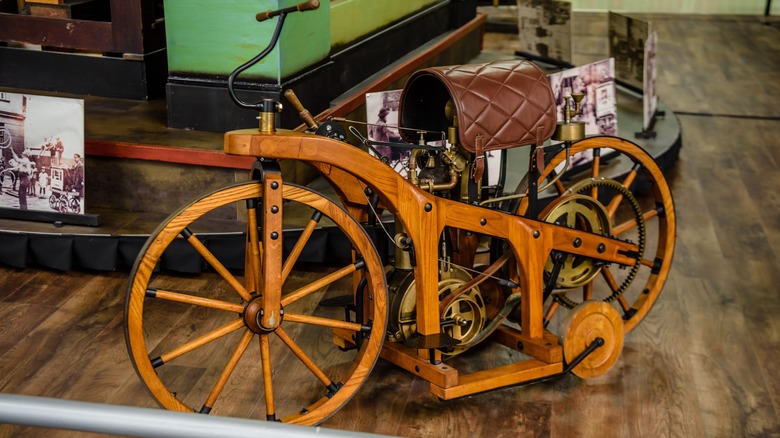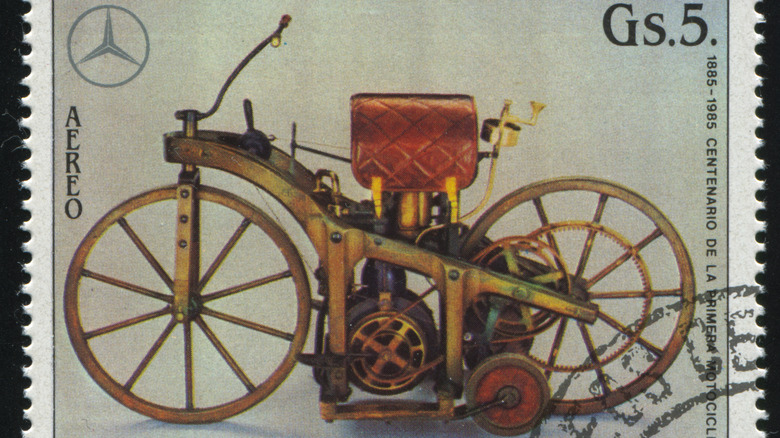How The Daimler Reitwagen Blazed A Trail For The Motorcycles Of Today
Technology is a wonderful thing and almost comical to look back on. After all, out of context, the specs of the innovative devices of the past are more than a little lackluster. For instance, the Wright Brothers' iconic Wright Flyer had a not-so-mighty 12 horsepower, while Carl Benz's 1885 car boasted 0.75 horsepower. It's not just about the numbers, though, but about what these extraordinary machines represented.
Just as the innovation of the Wrights led the industry to the most advanced fighter jets today, the creators of the first motorcycles inspired a process of more than a century of technological development and refinement. Admirers of the likes of the Top Oil-Ack Attack that achieved the Guinness World Record for Fastest Motorcycle Speed Achieved (376.3 mph) in September 2010 owe a lot of respect to the Daimler Reitwagen, its rather distant ancestor.
This remarkable machine from 1885 was a real pioneer in motorcycle history. For some, it was the very beginning of that history. It's a story that anyone interested in motor vehicles should be familiar with.
Setting the scene for the Daimler Reitwagen
The late 19th century was a fascinating time for the development of transportation. The internal combustion engine was just starting to be developed, as engineers were beginning to experiment with the potential of known power sources of the time. As Hugo Wilson writes in "The Ultimate Motorcycle Book," it had become clear that "replacing steam pressure with a controlled explosion was a logical move."
Around this time, the bicycle was seeing exciting developments. The invention needed to be more comfortable and practical, and the iconic penny-farthing was the beginning of an attempt to redress the balance (literally). The vastness of its front wheel made for a more stable and comfortable mode of transport than the crude bicycles of before but still rendered it impractical to mount. The vital breakthrough was coming, though, as Wilson writes: "The motorcycle chassis can be clearly traced back to Rover's Safety Bicycle built in 1885 by John Kemp Starley."
This machine was so named because its pedals-and-chain system allowed for two largely symmetrical wheels of less dramatic size than a penny farthing, reducing the risk of accidents.
Meanwhile, Carl Benz pioneered the one-cylinder stationary internal combustion engine, which he completed in 1879. A few short years later, another such engine would be mounted to a frame similar to Starley's, and the Daimler Reitwagen would be born.
The little wooden motorcycle that could
Gottlieb Daimler devised an internal combustion engine (ICE) of his own, and in 1885, he took the vital step of fitting it to a bicycle body. Unlike earlier acclaimed efforts, such as Sylvester Roper's steam-powered "motorcycle" of approximately 1867, this machine was powered by an engine as we'd more or less understand an ICE today. Outputting a potent-for-the-time 0.5 horsepower, this engine was a sleek, distinctly steampunk design.
Operation of the Daimler Reitwagen (loosely translated as "riding car") was a mechanically complex prospect. With an exhaust directly behind the seat and a gear-and-belt system connecting power and brake, it was, essentially, the skeleton of a motorcycle.
With an exterior frame largely constructed from wood, it isn't the most aesthetically-pleasing of rides, and its power output would scarcely even register compared to the mighty hogs of today. A top speed of approximately 7 mph, after all, isn't what you'd call blistering by any stretch of the imagination. However, it would be impossible to overstate how important this rudimentary machine would prove to be.
Steam engines would prove to be increasingly impractical to implement as the world advanced into the twentieth century, requiring more effort for less power and demanding often painstaking and expensive cleaning and maintenance. The Reitwagen proved to the world that there was an alternative and a far more convenient one. By so doing, it began an automobile revolution.
The legacy of the Reitwagen
Over 150 years later, the Reitwagen may look like little more than a quaint curiosity, such as you might see in replica form in museum exhibits. Like all pioneering pieces of technology, it has long since been thoroughly rendered obsolete by what arrived in its wake. Nonetheless, those motorcycle models that so eclipsed it may never have existed without it.
Of course, it was no simple leap from the Daimler Reitwagen to the Honda CB1000 Hornet. As is typical, decades of incremental developments saw motorcycle technology slowly and steadily improve. Its carburetor, for instance, was of the float meter type, and Maybach, Daimler's colleague, would introduce a carburetor with a spray nozzle in due time. The wooden frame of the machine, too, was a crucial element to improve upon: The Reitwagen's ignition apparatus, referred to as a "hot-tube ignition," destroyed the early motorcycle when it caught fire (causing a redesign with a more sophisticated transmission and other changes).
This technological marvel didn't just blaze a trail (literally) for motorcycles. The very next year, Carl Benz's three-wheeled "Velocipede" began to take shape. It was born of Benz's pursuit of, quotes Mercedes-Benz Group, a machine that was small "in terms of weight, but a titan in terms of power." Such a balance was impossible to strike with steam engines, and the Reitwagen demonstrated the potential of ICEs. This humble wooden package, among the most unique concepts for a motorcycle ever, was an enormous influence.



